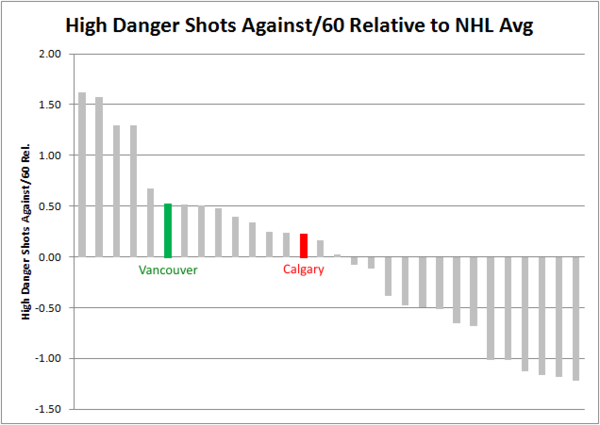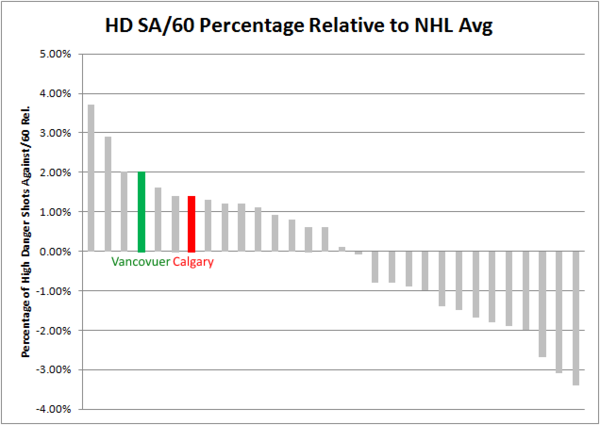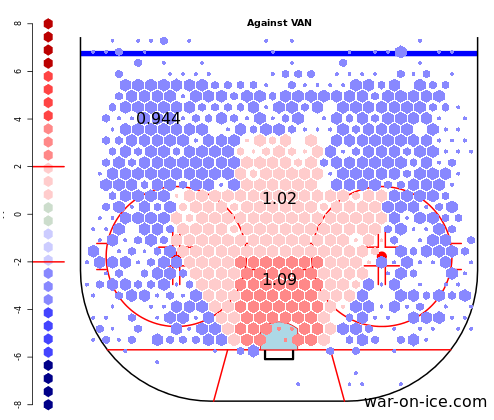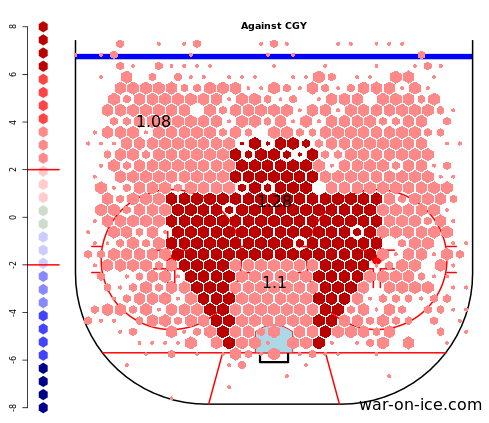Margins of victory are pretty slim in the NHL these days, and there’s not a whole lot separating the good teams from the bad anymore. Regular season games are most often decided by a single goal, parity is no longer a concept so much as a rule, and the race for Stanley Cup is wide open.
We know that to win in the playoffs, you usually have to be a really good team – not just by record, but by the underlying metrics as well. You’ve heard the old adage “defense wins championships”? Well it’s true, the marginal value of one shot prevented is greater than the marginal value of one shot generated. Defense really is the name of the game.
So how does Vancouver’s team defense stack up to the rest of the teams in the NHL? Are they good at keeping the puck out of their own zone? Do their systems limit scoring chances against?
The link between scoring chances allowed and actual goals permitted is still murky thanks to differences in goaltender skill and other variable factors. We can separate a team’s defensive performance from that of their goaltender by looking not only at how many shots a team allows, but by the location of where those shots against are coming from. Remember: we care about goal frequency, which is driven predominately by shot quantity, but is also influenced by shot quality.
Because this is the case, we can say that teams that give up a large number of shots from dangerous areas are rather poor defensively. How did the Canucks stack up relative to the rest of the NHL? Let’s have a look:

Teams on the left of this graph are giving up more shots, so they can be considered worse defensively. Vancouver and Calgary, their first round playoff opponent, are highlighted.
Vancouver allows high danger shots at a rate directly comparable to the Columbus Blue Jackets, New York Islanders, Dallas Stars, and Edmonton Oilers – not exactly great company to be keeping in any defensive category – but still not close to as many as Toronto, Buffalo, Colorado, or Arizona.
But is this because Vancouver’s puck possession game is so bad that they just allow more total shots from all areas, or are proportionately more shots actually coming from high danger areas? We can check this by looking at the percentage of total shots allowed that are from high danger areas, and compare it to NHL average. Once again, teams on the left of the graph are giving up more high danger shots, and are likely more permissive defensively:

The Canucks give up the same proportion of high danger shots to total shots as the Toronto Maple Leafs. On the other side of the ledger, the New York Islanders and Tampa Bay Lightning are the two teams on the very left of this graph, which lends credence to the fact that offense and being able to out-generate your deficiencies matters too.
Putting the two together, we can infer that the Canucks struggle in the defensive zone, which should come as exactly zero surprise to anyone who has watched the games. “How did that guy get so wide open!” would’ve been the slogan for all non-Edler/Tanev Canucks D this year, had the slogan not already been “pizzas for everyone!”
Why this is the case is a question for another day. It could be systems, it could be personnel, or it could be a combination of both. For what it’s worth, Luca Sbisa, Ryan Stanton, and Kevin Bieksa have all given up scoring chances at an obscenely high rate for defensemen that spent all year on a playoff team. In terms of scoring chances against per minute, only Kris Russell, Dennis Wideman, and Brian Strait were more permissive among playoff bound D whose numbers weren’t torpedoed by playing on Buffalo.
In terms of total shot volume against, Vancouver is basically exactly average (15th in the NHL in 5v5 Shots Against/60 per War-on-Ice.com), but, as indicated by the graphs above and the hextally chart below, this isn’t entirely due to average in-zone defensive play. The Canucks appear to be good at taking away shots from the perimeter of the zone, but the trade-off seems to be more shots allowed from the low slot and in front of the net – the areas on the ice you least want opponents to have the puck.
Note: on the following charts, blue indicates fewer shots, which is good. Red is the opposite.

While I wouldn’t characterize any of the above as “good news,” Vancouver Canucks fans can at least take solace in the fact that their first round opponent is also among the worst teams in the NHL, not just in quality of chances given up, but by sheer volume too. If there was a single team you had to point to in these playoffs to identify as a paper tiger, it would be the Calgary Flames:

If Vancouver does make it out of the first round, team defense could prove to be a real problem. Not only do they allow more high-danger shots than the majority of NHL teams, but a larger than normal portion of the shots that the Canucks allow are from prime scoring areas. In a league that is this low scoring, where the margins of error are so thin, a deficiency in team defensive ability may cost the Canucks in the long run.
Fortunately, their short-term foe suffers from the same deficiencies, if not worse.

